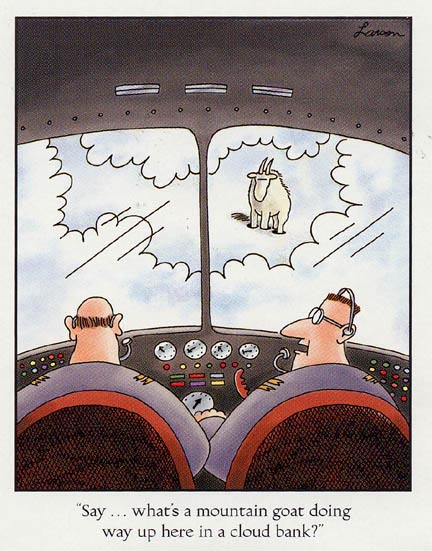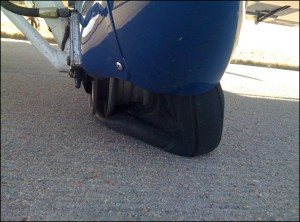A classic from the Far Side:

Golf Hotel Whiskey: for pilots and aviation enthusiasts
A classic from the Far Side:

Good news for UK pilots who thought flying was really expensive: Its actually cheaper to park your aircraft at a UK airport than to park your car at one! Specifically and according to a survey by the The Independent that was also picked up by the Daily Mail, its cheaper to leave your six-seater light aircraft on the tarmac for 24-hours rather than your car in a short-stay car park with  the widest disparity being found at Liverpool John Lennon Airport where a 24-hour short-stay for a vehicle costs £39.99 but parking your aircraft will cost you just £10.72.
the widest disparity being found at Liverpool John Lennon Airport where a 24-hour short-stay for a vehicle costs £39.99 but parking your aircraft will cost you just £10.72.
The most expensive airport for parking was Heathrow Terminal 5 which has a 24-hour rate of £51.80 – more than the cost of an off-peak flight to Aberdeen. Of course, Heathrow along with Gatwick and Stansted do not routinely handle light aircraft.
Manchester, the biggest regional airport in the UK, will charge £35 for 24 hours in the short-stay car park but if you want to park your six-seater Piper PA-46 there, it will only cost you £21 because such an aircraft weighs just under two tonnes. However, Emirates, which flies a "superjumbo" A380 between Manchester and Dubai, pays nothing for parking because the first four hours are free and they only keep the aircraft on the ground for 105 minutes. Likewise, some airports like Birmingham will also charge motorists just for dropping off passengers but if you are an aircraft owner, you can get up to two hours of free parking.
Meanwhile and up in Scotland, Edinburgh and Glasgow will charge you £23.50 and £21.00 respectively to park your car but it will only cost £11.90 and £11.52 to park a two-tonne plane (However, Glasgow will double parking fees for aircraft owners who are not regular users of the airport).
In other words and the next time you fly (whether its commercial or your own private aircraft), take public transportation to the airport (and quit complaining about how expensive the UK makes it for private pilots to fly!)
Ron, the blogger behind the House of Rapp blog, has written a detailed post with everything you could possibly want to know about aircraft tyres (or tires if you are outside the UK…) as they (along with constant-speed propellers) are one of his soapbox issues. Moreover, aircraft tyres are an important part of an aircraft that is often ignored – just like the tyres of your car.
However, ignoring your GA aircraft’s tyres can be dangerous as Ron noted that:
…tire failure on the takeoff or landing roll can lead to loss of directional control, runway excursion, and/or a ground loop. These things are unlikely to be fatal but are frequently embarrassing and inconvenient as they’ll shut down the runway for a while. I’ve had several of those in my career.
Ron then told the story of how he had stopped for cheap fuel in Limon, Colorado, on a paved but little-used airstrip on the edge of a small town. After he refueled and started to taxi, the left main tyre slowly deflated and as soon as his foot came off the brakes, the aircraft weathervaned into the wind – taking off the tire rim and making the aircraft immovable. At this time, the sun began to set and Ron was sitting in an unlighted biplane on a runway that luckily was not exactly a popular place for night landings.
 Ron then pointed out that the FAA has recently issued Safety Alert for Operators (SAFO) bulletin 11001 entitled “The Importance of Properly Inflated Aircraft Tires.” The bulletin noted that research has shown that transport-category aircraft can lose as much as 5% of tyre pressure per day under typical operations – meaning it would only take a few days before the tyres require servicing. In addition, Gulfstream has recently reviewed tyre safety “best practices” in their weekly Breakfast Minutes publication which also referenced the Goodyear Aircraft Tire Care and Maintenance publication.
Ron then pointed out that the FAA has recently issued Safety Alert for Operators (SAFO) bulletin 11001 entitled “The Importance of Properly Inflated Aircraft Tires.” The bulletin noted that research has shown that transport-category aircraft can lose as much as 5% of tyre pressure per day under typical operations – meaning it would only take a few days before the tyres require servicing. In addition, Gulfstream has recently reviewed tyre safety “best practices” in their weekly Breakfast Minutes publication which also referenced the Goodyear Aircraft Tire Care and Maintenance publication.
There are plenty of good reasons to be issuing alerts about tyres as Ron also noted that tyre failures have already caused a variety of high-profile jet accidents. These accidents include Air France flight 4590, Mexicana flight 940, Nigeria Airways flight 2120 and the 2008 crash of a Lear 60 in South Carolina. Moreover, improperly inflated tyres in turbine aircraft are more likely to lead to expensive damage or even catastrophic consequences because these aircraft have higher speeds and are heavier.
Ron’s entire post is packed with useful information about aircraft tyres and hence, its well worth reading.
The Daily Mail has recently reported that Boeing, Gulfstream and Lockheed Martin (with help from NASA) will be unveiling concepts for supersonic business jets that will have the capability of flying 2,500 mph and fly from London to Sydney in just four hours at the upcoming Farnborough Air Show.
Moreover, all three companies believe they are close to reducing the sonic boom that such a jet would produce to a sound that is “closer to a puff or plop” according to a Gulfstream engineer but aircraft makers will still need to prove to skeptical politicians that such jets and the sonic booms they produce will be acceptable to the public. After all, it was the sonic booms produced by the Concorde that helped to make the aircraft less commercially viable as they were forced to fly routes away from land.
Nevertheless and from a technical standpoint, the new supersonic business jets would use lighter composite materials, smaller fuselages and more advanced engines than the Concorde which had flown at speeds of up to 1,358 mph. Hence, passengers on the new supersonic business jets will travel at speeds of more than 2,485mph on a 12,000 mile flight from London to Sydney. In contrast, the Gulfstream’s new G650, which is currently the fastest subsonic executive jet, flies 7,000 miles at a 646mph and has a top speed of only 704mph.
Hence, the proposed 12-seat aircraft, which are expected to cost as much as $80 million each, are being marketed to wealthy European and Middle East buyers with the slogan: “To the USA and back in a working day.”
Source: The Daily Mail
Arguing with a pilot is like wrestling with a pig in the mud, after a while you begin to think the pig likes it…
— Seen on a General Dynamics bulletin board and posted on skygod.com. It was Mark Twain who said, "Never try and teach a pig to sing. It’s a waste of your time, and it annoys the pig."
Let’s face it, flight training is an expensive passion but John Fiscus, the Chief Pilot of the Flight Academy, recently wrote a short post for the Cirrus Owners & Pilots Association (COPA) website with a few tips about how to keep flight training costs at a manageable level. Specifically, John had been asked on another forum whether or not it would be worth training in small bites whenever money was available or to just save up for a year+ in order to do it all at once.
John recommended that most people can go a week or 2 during the early stages of flight training and not experience a significant recession. However and beyond that, you will likely find yourself working hard to just do the basic things. Hence, John suggested establishing a personal minimum for time between flights because if you see yourself going a week or more between lessons, you will end up spending the entire next lesson attempting to get back to where you should be rather than learning a new skill. Its also important to study the books before even a first flight as filling your own head with knowledge will always be cheaper than paying someone else to do it for you.
Otherwise, saving up prior to training will allow you to pace yourself better with the best way to train being to spend several full days in a row and then a break for a few days in order to study and recuperate. Likewise, several consecutive half days can also work.
However, John advised NOT to let a flight school talk you into doing just an hour or two per session. After all, what’s good for the flight school (either because of scheduling constraints or because they want to earn more money off their students by having them train for a longer period of time) may not be best for you or for your budget.
Finally, John wrote that you should be very picky about your flight instructor. In other words, don’t let the flight school just assign you one without you having interviewed several. After all, there are often two types of flight instructors: Ones who are there to build up their hours and the ones who actually care about teaching you to fly.